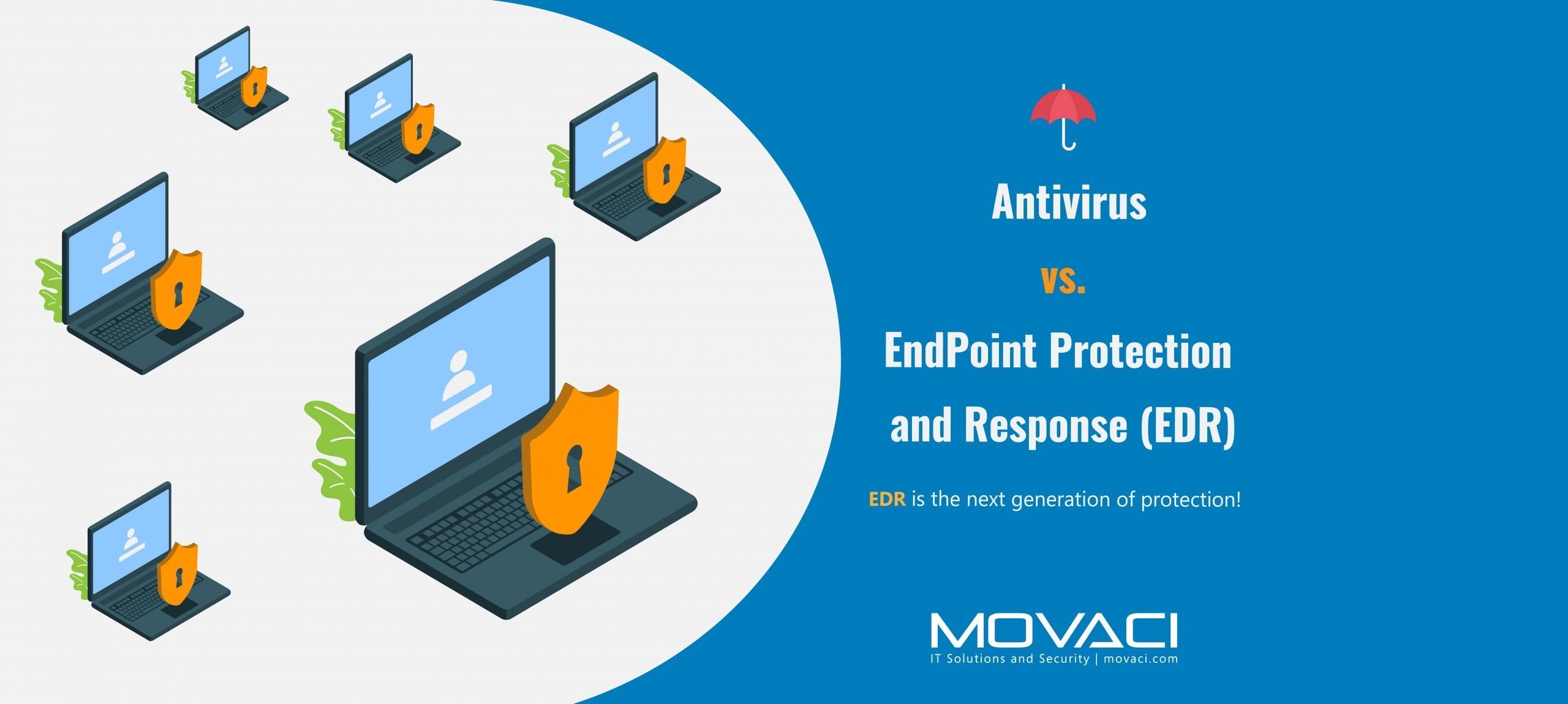For many organizations, big and small, network security is an issue which is too often neglected....
Antivirus vs. Endpoint Detection and Response (EDR)
Traditionally, antivirus has been sufficient to project organizations computer systems (also known as endpoints). EDR is the next level of protection – but what is the difference between Anti-virus vs. Endpoint Detection and Response?
What is Endpoint Detection and Response (EDR)?
Endpoint Detection and Response (EDR) solutions are tools which assist in the detection and investigation of suspicious activities across all the endpoints in your organization. It is becoming the preferred technology for organization to provide more robust security for their networks when compared with the traditional antivirus.
How does EDR work?
EDR solutions work by monitoring network and endpoint events and storing the information on a centralized database for further analysis, investigation, or reporting. Suitable software is installed on the host which helps in real-time data monitoring and reporting on the potential threats.
Benefits of Using an EDR
EDR systems have become a must-have for all modern-day organizations to protect their digital perimeter from evolving cyber threats and security issues. The key benefits of using an EDR system in your organization are discussed below:
Comprehensive Data Collection and Monitoring
EDR solutions collect comprehensive data on potential attacks and continuously monitor all the endpoints of your digital perimeter both online and offline. The data collected facilitates investigations and incident response. The data is collected and stored on the endpoints and it is mapped against the security threats for detection of threats.
You can get in-depth insight and understanding regarding the anomalies and vulnerabilities of your network and prepare better strategies to protect it from cybercriminals.
Detection of all Endpoint Threats
One of the biggest benefits of using EDR security systems is its abilities to detect all endpoint threats. It provides you visibility on all the endpoints of your digital perimeter.
It is superior to the traditional antivirus or other tools which use signature-based or perimeter-based solutions in terms of identifying potential threats. It can help your IT teams to understand the nature of potential attacks better and prepare the appropriate response for the same.
Provides Real-Time Response
EDR solutions can provide real-time response to different potential threats. You can see the potential attacks and threats as they are evolving in the network environments and can monitor it in real-time.
This real-time response feature of EDR solutions is very useful and can cut off the attack in its initial stages before it becomes critical for the network. You can spot the suspicious and unauthorized activities on your network and can get to the root cause of the threat, thereby enabling a better response from you. This is a huge benefit when you compare Anti-virus vs. EDR.
Compatibility and Integration with Other Security Tools
EDR systems have become highly advanced and they are being designed to be compatible and integrate with other security tools. This integrated approach provides excellent security to the network from potential cyber threats and attacks. It allows you to correlate data pertaining to network, endpoint, and Security Incident and Event Monitoring (SIEM). This enables you to develop a better understanding of the techniques and behaviors used by cybercriminals to hack into your network.
Antivirus vs. EDR
Some of the key differences between EDR and traditional antivirus are summarized below:
Scope
Traditional antivirus programs are more simplistic and limited in scope compared to the modern EDR systems. Antivirus can be perceived as a part of the EDR system.
Antivirus is generally a single program which serves basic purposes like scanning, detecting and removing viruses and different types of malware.
EDR security systems, on the other hand, serve a much larger role. EDR not only includes antivirus, but it also contains many security tools like firewall, whitelisting tools, monitoring tools, etc. to provide comprehensive protection against digital threats. It usually runs on the client-server model and protects the various endpoints of an enterprise’s digital network and keeps the endpoints secure.
Ability to Protect Enterprise Architecture
With technology becoming an integral part of business, the digital perimeter of the modern-day enterprises keeps on expanding rapidly. Traditional anti-virus is insufficient to protect such large scale and continuously expanding the digital perimeter.
Anti-virus is more of a decentralized security system which falls short of providing adequate security to the ever-expanding digital networks. This is why so many organizations are comparing Anti-virus vs. EDR. The IT network and perimeter of enterprises have witnessed even faster growth due to the mobile revolution. While a growing digital network and perimeter can be beneficial to the business, it is also more vulnerable to cyber-attacks as it can be breached from more numerous endpoints.
This is where the EDR security systems play a vital role in ensuring the safety and security of the digital perimeter. They provide centralized security and continuously monitor the security threats across all the endpoints of the network. It provides much better and holistic protection to your digital network from hackers who are also growing smarter.
Ability to Spot Endpoint Threats
Cybercriminals are becoming more adept and smarter at their trade and using advanced threats to breach into networks. Traditional antiviruses provide you a basic level of protection from such advanced cyber-attacks and are not sufficient to meet your network security needs.
A traditional antivirus program detects malware and viruses by signature-based detection which is loaded in its database. However, hackers are now capable of creating malware with continuously evolving codes which can easily fool and bypass traditional antiviruses.
EDR systems detect all endpoint threats and provide real-time response to the identified threats. It can help you understand the complete scope of the potential attack which increases your preparedness for such attacks. EDR systems also collect high-quality forensic data which is needed for incident response and investigations.
Overall, EDR security systems are much better equipped at handling cyber threats than traditional antivirus.
Movaci Managed EDR
Managed Endpoint Detection and Response uses artificial intelligence to stop advanced threats and malware at the most vulnerable point – the endpoint. Antivirus isn’t enough to protect your endpoints!
Movaci EDR, powered by SentinelOne, provides advanced security protection by using multiple AI engines, providing complete visibility into all activity, and even rolling back threats with a single agent. As a result, customers gain operational efficiencies by not having to manage multiple products, technologies along with signatures, polices and deployments.




